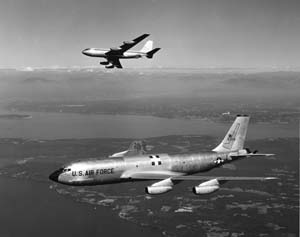USAF’s tanker modernization odyssey has brought a decade of frustration. Boeing and EADS are now facing off in a competition to supply the Air Force with a critical “KC-X” tanker. US Aerospace would like to join them, and is protesting its exclusion from the competition, after the Defense Department said the company delivered its proposal five minutes late. When it comes to tanker modernization, this level of chaos is all par for the course.
It is hoped the Air Force will pick a winner this November to deliver 179 aircraft, over 12 years, for some $35 billion. Two more competitions will follow in later decades, so the entire fleet of 415 KC-135Rs can be retired.
“I’m going to cut to the chase,” said Gen. Arthur J. Lichte, then head of Air Mobility Command, at AFA’s Air and Space Conference in Washington, D.C., last September. “We need tankers now. I stood here at the AFA forum in September 2007 and said tankers were my No. 1 priority. I said it last year. I said it this year. And I still don’t have a new tanker.”
Lichte has since retired, and there is no new tanker.
The competition is bitter. Competitors and their proxies are taking public swipes at each other, employing massive advertising campaigns and enlisting the support of friendly lawmakers. The stakes are high.
 |
|
It is critical that USAF get things right: Under current plans, the oldest KC-135s will be 80 years old when finally retired. More delay simply cannot be tolerated.
How did things get to this sorry pass
Secretary of the Air Force F. Whitten Peters sounded the tanker modernization alarm fully a decade ago. USAF had “no significant plans on the books” to replace its KC-135s, he warned. “We do not have a dollar programmed at this point to replace our aging tanker force, probably the most important part of our infrastructure,” he added.
Tanker modernization moved up in the requirements queue after the Sept. 11, 2001 terror attacks. Boeing and Air Force supporters in Congress saw potential synergy: If USAF leased 767s as tankers, that would supply a critical Air Force need and help Boeing weather a crisis brought on by the post-9/11 collapse of air travel. In January 2002, lawmakers authorized the Air Force to lease 100 tankers.
To address concerns about cost and legality, lawmakers in 2003 revised the deal so USAF would lease the first 20 aircraft but buy 80 outright.
That agreement didn’t last, either; it collapsed in a legal scandal that eventually put Air Force acquisition executive Darleen A. Druyun and Boeing executive Michael M. Sears in prison.
DOD attempted to move on. It began a new competition, in which Boeing battled a partnership of Northrop Grumman and EADS. The Northrop-led team was the surprise winner in February 2008, but Boeing immediately protested the decision, claiming the competition was flawed—partly because the competition’s draft rules were modified after Northrop threatened to stay out of the contest.
The government upheld the protest, and DOD was forced to start over once again.
Northrop Grumman chose not to enter this year’s competition—even though it had won the previous go-round. The company felt the revised rules favored Boeing to the extent that Northrop Grumman had no realistic chance of winning. For a short time this year, it looked like Boeing would be the only candidate. Then EADS, parent company of Airbus, put its hat in the ring—but only after DOD agreed to extend the entry deadline by 60 days. That move generated howls of protest from Boeing supporters.
Boeing’s 767-based tankers would be assembled in Seattle and modified in Wichita, Kan.; the company claims 50,000 jobs would be supported. EADS would assemble its larger Airbus 330-based tankers in Mobile, Ala., and claims the program would support 48,000 jobs.
The fireworks haven’t stopped.
“Unlike the Boeing tanker, which would be built at proven facilities by experienced workers, Airbus planned to assemble its tankers at facilities which haven’t even been built yet,” said Sen. Patty Murray (D-Wash.).
“If the welfare of our warfighters trumps politics in this competition, the Air Force will select the EADS tanker,” countered Sen. Richard Shelby (R-Ala.). “It is clearly the most capable plane.”
EADS touts the capabilities of its larger aircraft; Boeing says its design is more efficient. The Pentagon does not want to take sides on the point: “This is a best-value competition,” noted Deputy Defense Secretary William J. Lynn III. “A bidder could actually have a higher proposed price and still win.”
As if things weren’t contentious enough, the World Trade Organization in June finalized a ruling against Airbus, saying the company received billions of dollars in illegal “launch aid” from European governments to help develop its aircraft. This gave EADS a competitive advantage over Boeing, the WTO ruled.
DOD has tried to stay out of this issue as well, and has repeatedly said the WTO rulings cannot be factored into the current competition. Indeed, the European Union is now appealing the WTO’s decision.
There will be bruised feelings and possible grounds for appeal regardless of which tanker the Air Force selects as its KC-X winner this fall. The parochial interests are strong, but from the national security perspective, the important thing is to field a new system.
The worst possible outcome is a flawed competition forcing yet another redo.
| More information: http://opencrs.com/document/RL34398 |